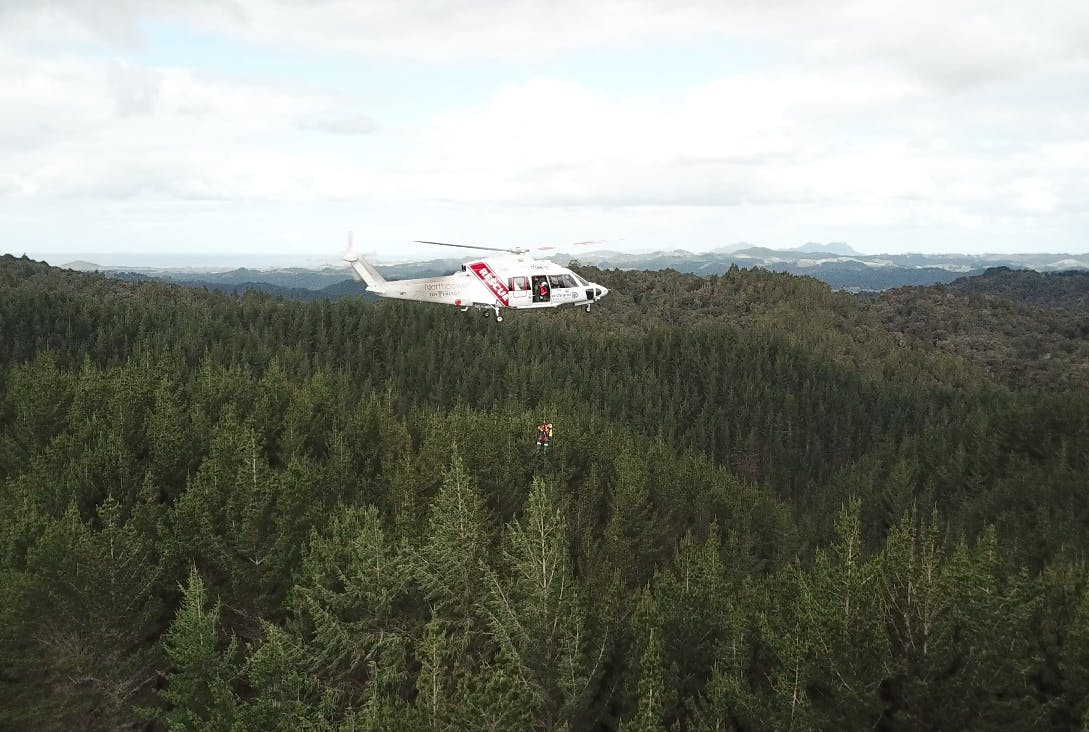If a chopper is on the way, here’s how to best prepare for the incoming rescue. By Northland Rescue Helicopter captain Susan Dinkelacker.
When someone needs rescuing, it’s all go go go. Each member of a typical four-person helicopter rescue crew has a pre-assigned task: the two pilots plan the flight and calculate how much fuel will be required; the winch operator and medic install harnesses and gear. Then systems are checked, a team briefing is held and within minutes, the helicopter launches.
If you’re the one who called for help, here’s how you can ensure an efficient helicopter rescue.
Got your PLB?
A PLB is your best bet for a quick rescue. Switch it on and leave it on until help arrives. Leaving it on allows the chopper crew to zero in on your location. Remember to switch it off once you’ve been assisted.
Phone it in
If you don’t have a PLB, the next best option is your smartphone. It’ll be worth your while to become familiar in advance with how to find your GPS coordinates on your phone. For example, on Android Google maps, press and hold an unlabelled spot on the map, and a red pin will appear. The GPS coordinates will show in the search box at the top.
If you’re lucky, you’ll have cellphone coverage where the incident has occurred, otherwise, someone will have to run to higher ground in order to call 111. For this reason, it makes sense to occasionally check for cellphone coverage when tramping in rugged terrain.
Clear the way
With the helicopter on its way, scout around for an opening in the forest canopy. A clearing on high ground with an open view of the sky, even if it’s some distance from the patient, will give the best chance for you to be seen from the air. If you have cellphone coverage, expect a call from the helicopter as they get closer. Explain the patient’s condition and as much descriptive detail as you can about where you are.
Clock in
If you can see the helicopter, use the clock system to let the pilots know where you are. Imagine a clock dial superimposed over the helicopter. As seen from above, the helicopter always points to twelve o’clock. If the helicopter is heading straight at you, tell the pilot: “I’m at your twelve o’clock”. If you see the right-hand side of the helicopter 90-degrees side-on, tell the pilot: “I’m at your three o’clock”.
Standout
On a search in thick bush near Whangarei Heads, I only spotted the patient because a single spindly tree was being vigorously shaken. Movement really catches the eye. Enroute to another bush rescue near Waitangi, I noticed something flashing from miles out. It turned out to be someone waving an emergency blanket over their head, scattering sunlight in all directions. At night, with the pilots using night vision goggles, shine your flashlight. At all times, keep waving, even when you are sure you’ve been seen – you look very, very small from above.
Heads up
When the helicopter is overhead and winching, be aware of branch fall danger. There will be a surprising amount of wind generated – the helicopter displaces as much air as it weighs, causing a strong downwash. Direct others to stay well clear. If the helicopter suffers a mechanical failure it may have to land suddenly.
Beam me up, Scotty
The medic will always accompany the patient as they’re winched to the helicopter. People who have been rescued this way say that having someone “on the wire” helps reduce the psychological stress of what can be a terrifying experience. As they reach the helicopter door, it helps if the patient remains as relaxed as possible and passively allows themselves to be swung around and pulled inside the cabin.
Stick the landing
Landing the helicopter is more efficient than winching. Pace out an area of at least 30m2. The larger and more open the area the better. It’s important to look all around to check that there are no wires in the vicinity or loose objects that may blow around. Flat ground is best, and on a hill rather than a dip to give the main rotor blades maximum clearance. It’s okay if the tail hangs over an edge, as long as the wheels (or skids) have a firm, flat place on which to perch.
To indicate where the helicopter should land, stand slightly upwind of the landing zone with your back to the wind and your arms extended out in front of you. Aircraft usually land into the wind which will mean it will fly towards you.
Once the helicopter gets close, move clear but stay where the pilots can still keep eye contact with you. If you need to point something out, exaggerate your body language by using your whole body. If you see something that would make the landing unsafe, wave the helicopter off by making big Xs above your head using sweeping arm movements.
Once the helicopter has landed, remember to keep your movements slow and predictable – this is no time to rush. Do not approach the helicopter while the rotors are turning unless specifically directed to do so by a member of the crew.







